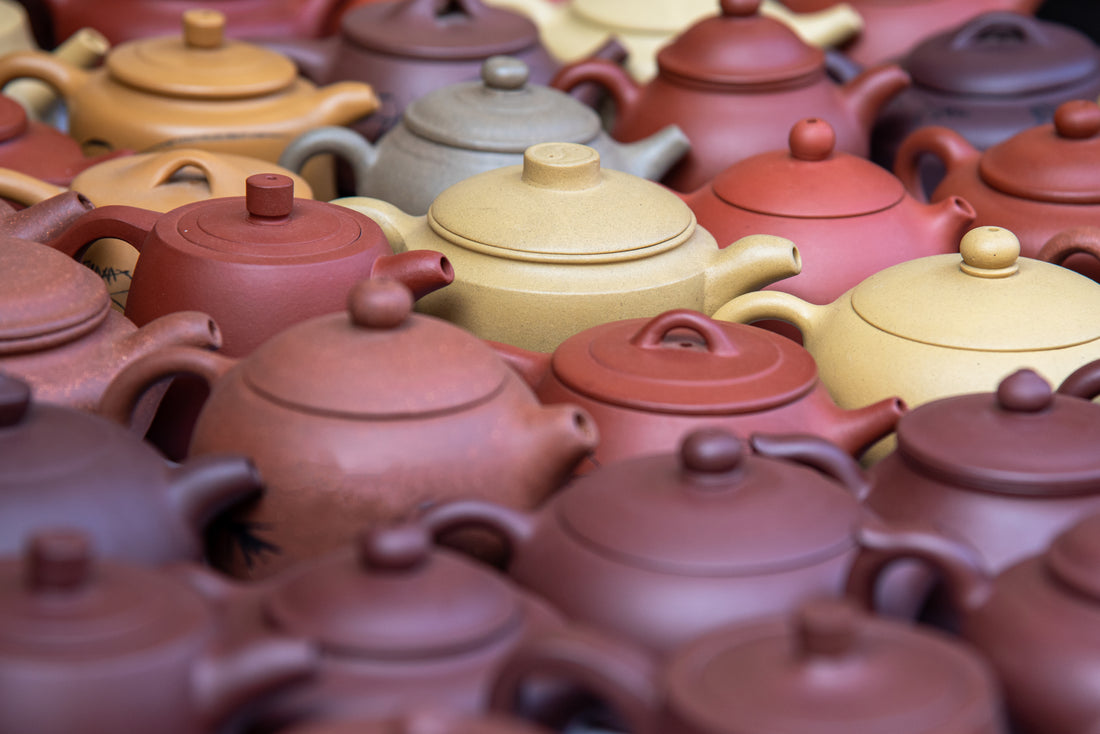Hello to all tea enthusiasts! At TeaJewel, we're always keen to introduce you to the treasures of the tea world, and today, we're diving deep into the art of Yixing clay. As you savor your favorite cup of red tea or delight in the rich aroma of pu-erh, there’s a good chance that a traditional Yixing teapot can elevate your tea-drinking experience. But did you know that there isn't just one type of Yixing clay? Let’s journey together into the rich world of Yixing clay types.
1. Zisha (紫砂, Purple Sand Clay) Zisha is the most well-known Yixing clay, often referred to as "purple sand" clay because of its distinctive color. However, its spectrum ranges from reddish-brown to purplish-brown. Zisha's porous nature allows it to retain heat well and enhances the flavor of tea, making it a favorite among tea connoisseurs.
2. Hong Ni (红泥, Red Clay) Rich and beautiful, Hongni presents with a reddish hue and has similar properties to Zisha. Due to its finer texture, Hongni is often used for intricate and detailed teapot designs. Teas brewed in Hongni teapots are known to take on a sweeter, smoother quality.
3. Duan Ni (段泥, Fortified Clay) Duan Ni is a mixed clay, encompassing a wide range of colors from yellow to green and even beige. This clay's unique appearance is due to the fusion of various minerals and stones. Duan Ni is celebrated for its artistic appeal and is perfect for those who seek unique aesthetics in their teaware.
4. Lu Ni (绿泥, Green Clay) As the name suggests, Luni has a greenish tint and a slightly coarser texture than the other types. Luni teapots are perfect for those who love to brew green and white teas, as this clay accentuates the fresh and delicate flavors of these teas.
5. Hei Ni (黑泥, Black Clay) Heini is a dark, almost black clay. It's less porous than Zisha but has a smooth texture, making it a favorite for creating sleek, contemporary teapot designs. Heini's heat retention properties are impeccable, and it’s especially suited for oolongs and pu-erhs.
6. Qing Shui Ni (清水泥, Clear Water Clay): Among the diverse family of Yixing clays, Qingshui Ni stands out with its serene, grayish-green hue, reminiscent of tranquil waters. Often referred to as "Clear Water Clay," Qingshui Ni is cherished not just for its unique color but also for its versatile properties suitable for a wide range of teas.
7. Zhu Ni (朱泥, Vermillion Clay): Zhu Ni, known as Vermillion Clay, is one of the most esteemed and sought-after varieties within the Yixing clay spectrum. Recognizable by its captivating bright red hue, Zhu Ni boasts a finer, smoother texture compared to many of its counterparts. This clay's exceptional properties not only make it a favorite for intricate teapot designs but also enhance the overall tea-drinking experience. Brewed within a Zhu Ni teapot, teas often exude a rounder, mellower taste, with subtle sweet undertones. However, the rarity and increasing demand for genuine Zhu Ni have made it a premium choice in the realm of Yixing teaware, symbolizing both luxury and traditional artistry.
8. Ben Shan Lu Ni (本山绿泥, Original Mountain Green Clay): Hailing from the vibrant lineage of Yixing clays, Ben Shan Lu Ni, or Original Mountain Green Clay, captivates with its soft greenish-blue hue. Its name, reflecting its origins from the "original mountain" deposits, carries a sense of history and authenticity. The clay’s slightly granular texture provides a tactile pleasure when held, yet its refined nature allows for delicate craftsmanship in teapot design. With a moderate porosity, Ben Shan Lu Ni teapots are particularly adept at preserving the nuanced flavors and aromas of delicate teas, such as green and white varieties. As a beautiful melding of form and function, this clay has garnered the appreciation of tea lovers who seek both aesthetic charm and exceptional brewing quality in their teaware.
9. Jiang Po Ni (江坡泥, Riverbed Clay): Amidst the rich tapestry of Yixing clays, Jiang Po Ni or Riverbed Clay stands as a testament to nature's artistry. As its name suggests, Jiang Po Ni draws its essence from the age-old riverbeds, carrying a deep connection to the land's history and geography. With a distinct yellowish tint, reminiscent of golden river sands, this clay presents a refreshing deviation from the more commonly known Yixing hues. Beyond its visual appeal, Jiang Po Ni possesses a medium level of porosity, making it versatile for a variety of tea brews. Its intrinsic capacity to meld with the character of teas and accentuate their depth makes Jiang Po Ni teapots a prized possession for those seeking an evocative and enriching tea experience.
10. Pin Zi Ni (拼子泥, Mixed Clay): As the name suggests, it's a mix of different clays. This type of clay can vary significantly in color and texture, depending on the specific mixture.
11. Dahongpao Zhuni (大红袍朱泥, Big Red Robe Vermillion Clay): Deep within the world of Yixing clays lies the exquisite Dahongpao Zhuni, a clay named after the revered "Big Red Robe" oolong tea. This variant of Zhuni clay is a marvel in its own right, possessing a vibrant reddish hue that's reminiscent of the deep tones found in the Dahongpao tea leaves. What sets Dahongpao Zhuni apart is its exceptionally fine texture and its unparalleled ability to bring out the delicate notes in teas, making it a treasured choice for tea connoisseurs.
Why Choose Yixing Teaware? Beyond the beauty and variety of Yixing clays, there’s a practical reason why tea lovers swear by them. Due to their porous nature, Yixing teapots gradually absorb the flavors of the teas brewed in them. Over time, you’ll find that your tea tastes richer and more nuanced, offering an unparalleled tea experience.
As you explore our collection at TeaJewel, whether you're looking for teapots, cups, or other exquisite Yixing creations, you're not just purchasing a piece of teaware. You're investing in a legacy of craftsmanship, tradition, and a partner for your tea journey.
So, next time you're indulging in a cup of gyokuro or genmaicha, consider pairing it with the right Yixing teapot. It's a union of two worlds, where the mastery of tea blends with the artistry of clay, promising an unforgettable experience.
Happy Brewing! 🍵

